Play has wrapped up at Gopher Lakes (Hazeltine National) in round 3 of my All-Time Greats (ATG) tournament, and I couldn’t be happier. The 1st round took place at Yatch Club (Harbour Town), where Lee Trevino (1971) jumped into the lead with an 8-under 63. In round 2, Jack Nicklaus (1975) moved to the top of the leaderboard with a 4-under 68 at Badger Links (Whistling Straits), 10-under overall.
The cut for my ATG tournament was 1-over par, which allowed 69 of the original 144 ATG golfers to move on from round 2 to 3. While Gopher Lakes proved to be brutally difficult for most of the remaining field, Nicklaus shot a 5-under 67, which tied for the best round score and put him 3 strokes ahead (-15) of the closest contender, Nick Price (1994), who finished the day at 12-under.
The reason for my joy is that Gopher Lakes is now behind me. Not only does it have an ungodly number of course notes that have to be factored into play, many of them trivial (e.g., Tee shots carry -5 yards), there are several holes with notes on putting that make scoring below par almost an impossibility (e.g., Read all putts two columns longer). This is the only APBA course I know of where it is actually possible to putt into the water!
Newer APBA Golf fans who have this course (and anyone who wants to score well) may want to ignore the course notes or at least the ones pertaining to putting. Alternatively, I advise restricting play to only those few golfers who are incredibly accurate and putt extremely well. Tom Watson (1977) got eaten alive at Gopher Lakes, finishing the round at 86 (14-over), mainly because he couldn’t find either the fairways or greens. despite favorable playing conditions.
Gopher Lakes has some pretty narrow fairways that are often lined with bunkers (some deep) and trees. While you can always use a shorter club off the tees for better accuracy, that would make several of the holes unreachable in regulation for most of the ATG golfers, who generally don’t hit the ball as far as modern players.
As the name suggests, water is another factor on this course. Trevino, who was 1-under for the round at the time, ran into problems on par 4 #16 when he sliced his second shot into Hazeltine Lake which surrounds the peninsular green (see image below). He was able to drop his ball in the rough at the 365-yard mark, but his approach came up a diagonal short of pin location 5, which meant his first putt had to be read a column longer (per the course notes). Unfortunately, he just missed the 14-footer, took a double-bogey 6, and finished the day at Even par.
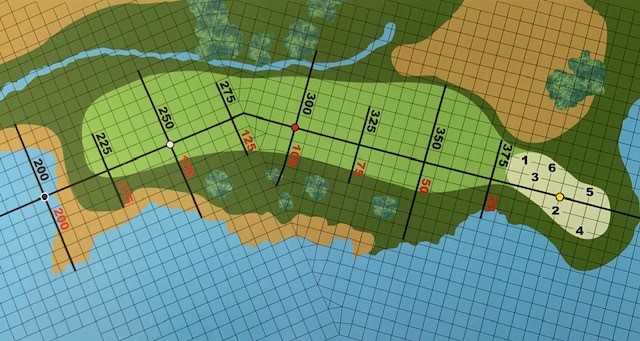
For the record, I’ve been playing this tournament using the Game Caddie and following all the APBA Master Game rules, except for a minor adjustment to how rolls are calculated when they cross over fairways, intermediate rough, and regular rough. I just use the roll associated with where the ball landed. (This is for simplicity sake and to save my eyesight!) All putts are read from the Regular Putting boards.
Here’s the top portion of the leaderboard, showing how the current leaders shot in Round 3 (R3 Rank) compared to Round 2 (R2 Rank).
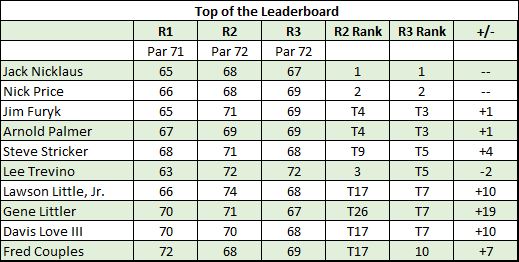
As you can see, Nicklaus and Price held their ground from rounds 2 to 3, while Trevino dropped a couple of places into a tie for 5th. The biggest mover in this group was Gene Littler (1959), who jumped from a tie for 26th to a tie for 7th (+19).
Here’s a list of the Biggest Gainers for round 3:
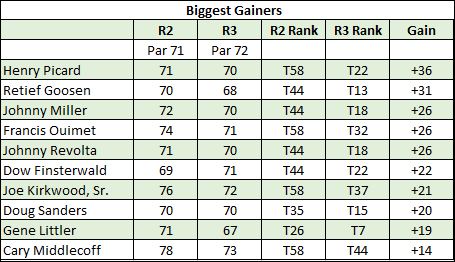
Henry Picard (1939) led the way of Gainers, climbing 36 positions on the leaderboard to finish the round in a tie for 22nd place. Littler was the only Gainer to crack the Top 10.
The Biggest Losers look like this:
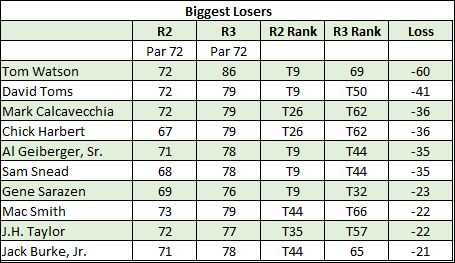
Besides Watson, four other golfers fell a proverbial mile from the Top 10: David Toms (2001), Al Geiberger, Sr. (1966), Sam Snead (1941), and Gene Sarazen (1930). Trouble finding the green haunted this group, as well as 30+ putts each, except for Sarazen (26).
Here is a full Tournament Summary through the first 3 rounds:
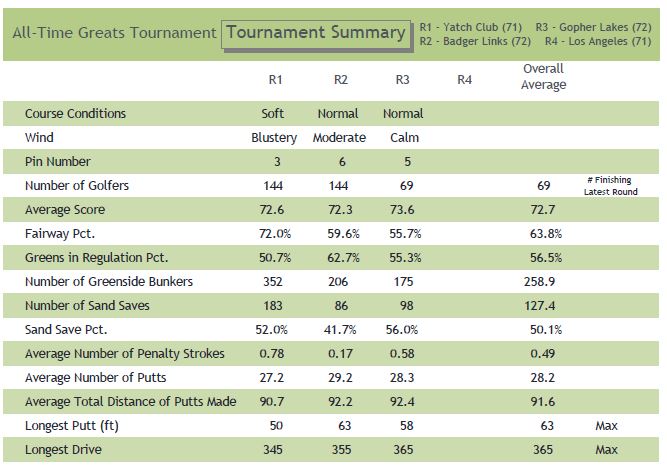
The average score this round was 73.6 (par 72), despite Calm winds and Normal course conditions. The slight improvement in average number of putts compared to the last round (28.3 vs. 29.2) is offset by a drop in Greens in Regulation (55.3% vs. 62.7%) and an uptick in penalty strokes (0.58 vs. 0.17).
The hardest hole was #12, a 518-yard par 4. This can be attributed at least in part to its requirement that all putts be read 2 columns longer and spacious bunkers guarding both front sides of the green. The average score was 4.67 strokes, and only three players managed birdies.
By contrast, the easiest hole was #8, a 176-yard par 3 with water in front and to the right side of the green. Fortunately, the pin placement was near the back left. The average score was 2.75 strokes and 30 players birdied this one.
You can view full tournament results through round 3 by clicking in the upper righthand corner of the PDF document below.